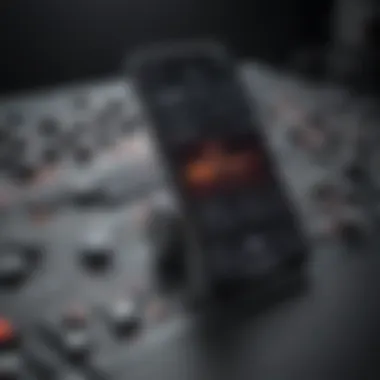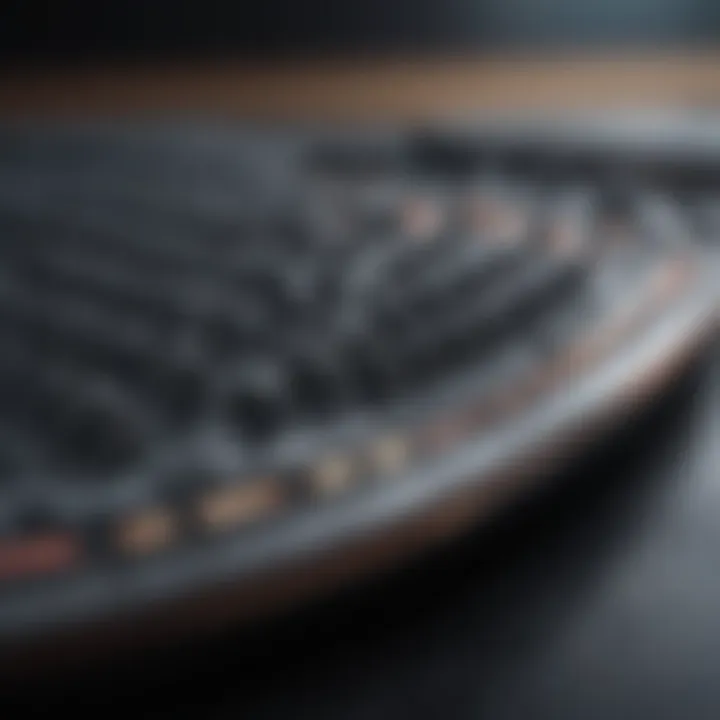Techniques for Isolating Vocals on iPhone


Intro
In the realm of music production and audio editing, isolating vocals is a skill that many aspire to master. With the increasing ubiquity of smartphones, particularly the iPhone, music enthusiasts and professionals now have the opportunity to work with high-quality audio right at their fingertips. This article delves into practical methods for isolating vocals directly on your iPhone, exploring various tools and applications that ease this process. Whether you're fine-tuning a personal project, preparing stems for mixing, or simply experimenting with sound, knowing how to effectively isolate vocals can dramatically enhance your audio work.
In this exploration, we’ll uncover strategies, tips, and possible roadblocks you may encounter along the way, ultimately aiding you in honing your audio editing skills. By the time you finish reading, you’ll have a rounded understanding of different methods and tools and how to leverage them for vocal clarity in your projects.
Product Overview
When it comes to isolating vocals using an iPhone, several applications come into play, but not all are created equal. Most noteworthy is a combination of different factors such as features, ease of use, and overall experience. Popular apps like Hokusai Audio Editor and Audacity (with some tricks) stand out for their capabilities.
Key Features and Specifications
- Hokusai Audio Editor: Intuitive interface with multi-track editing capabilities. Offers real-time effects, EQ, and a range of exporting options.
- Audacity via GarageBand: While not directly available on iPhones, using GarageBand as a groundwork gives you access to Audacity-like features through its interface.
Design and Aesthetics
Both apps deliver a user-friendly experience featuring sleek, modern designs which make navigation a breeze. You’ll often find that how an app looks can impact usability, and these applications do well in making audio editing more approachable.
Performance and User Experience
Performance varies by the specific app. Each has its strengths but ultimately aims to create an environment where users can manipulate audio with ease.
Performance Benchmarks
- Hokusai's Export Time: Quick rendering without excessive delay, making it suitable for on-the-run edits.
- GarageBand's Processing: Efficient in handling smaller projects while maintaining audio integrity.
User Interface and Software Capabilities
The interface of Hokusai allows for finger gestures to control layering, making it a great option for tactile audio manipulation. Its flexibility lets users quickly apply effects while working on multiple audio tracks simultaneously. Conversely, GarageBand uses a grid layout that may require a brief learning curve but offers powerful tools once mastered.
User Experiences and Feedback
Users appreciate the simplicity of navigating Hokusai, especially for quick tasks. Those more familiar with desktop software often find GarageBand to meet their performance standards tailored for iOS. A common sentiment echoes among users: "The learning curve is worth it for professional results."
"Each app breathes potential. It's like having a studio in your pocket."
Tips and Tricks
Attempting to achieve clear vocal isolation can be tricky but following a few simple tips can pave the way for success.
- Use EQ Adjustments: When isolating vocals, cutting lower frequencies can significantly reduce unwanted sounds.
- Explore Effects: Taking advantage of built-in effects like reverb or compression can bring vocals to the forefront.
How-to Guides and Tutorials
- Create a new project in Hokusai.
- Import your audio file.
- Isolate vocals by adjusting EQ settings, ensuring clarity.
Hidden Features and Functionalities
Both applications often include shortcuts and hidden settings; it's worth spending some time exploring these. For example, Hokusai allows for layering tracks, making complex edits more manageable.
Latest Updates and News
Tech evolves at lightning speed, and keeping track of recent changes helps maintain an edge in audio editing.
Recent Developments
Keep an eye on update releases for both Hokusai and GarageBand; these often introduce new effects and improve performance. Following forums or product pages could inform you of sneak peeks into upcoming features.
Industry News and Rumors


Speculation about Apple’s future endeavors often circulates among audio communities, with discussions on potential new audio editing features integrated into iOS.
As the landscape of audio editing shifts, staying updated through platforms like Reddit can provide invaluable insights to keep your skills fresh.
Intro to Vocal Isolation
Vocal isolation is a key aspect of audio editing that engineers and music enthusiasts across the globe constantly seek to master. This method is particularly essential when working with complex audio tracks comprising multiple instruments and vocal layers. By understanding how to effectively isolate vocals, one gains the ability to manipulate music compositions in a way that enhances the listener's experience. Whether you're mixing a track or creating a remastered version of a classic song, isolating vocals can offer a vast scope for creativity.
Understanding Vocal Isolation
Vocal isolation refers to the process of separating the vocal elements from other audio tracks. At its core, it's about taking a recording and pulling the singer's voice out from a cluttered mix. This technique arises from the necessity of working with stats that may be obscured by background noise or instrumentation. It's common in scenarios ranging from karaoke projects to professional music production, allowing users to focus solely on the vocals, without distraction.
It’s noteworthy that vocal isolation isn’t just about removing instruments. Sometimes, the goal is also to enhance a certain aspect of the voice itself, such as taking out unwanted breath noises or tuning inconsistencies.
Importance in Audio Editing
The capacity to isolate vocals carries significant weight in audio editing. For starters, it enables more refined mixing by allowing editors to tweak the vocal track independently of instrumentals. This distinction can drastically improve the balance and quality of a final mix. Imagine a situation where a vocalist’s passionate performance is buried beneath layers of heavy guitar riffs or a boisterous orchestra; the ability to draw out the voice becomes an invaluable asset. It also paves the way for remixing and sampling, giving artists the flexibility to create new interpretations of existing works.
Moreover, vocal isolation is a game changer for educational purposes; music students and aspiring sound engineers can dissect vocal performances to learn techniques and styles. This facet can greatly enhance one’s ability to produce high-quality audio.
Overview of Available Tools
In today’s digital landscape, a plethora of tools and applications exist for vocal isolation on various platforms, notably the iPhone. Each app comes with a distinct set of features, targeting different editing needs—from simple karaoke-style applications to powerful editing software. Generally, these tools utilize a range of approaches to isolate vocals, including equalization, phase cancellation, and machine learning algorithms.
Users can expect features such as:
- Real-time editing: Allows modifications as you listen.
- Visual waveforms: For clearer manipulation of audio.
- Multi-track support: Ideal for complex projects combining various audio sources.
At the crux of vocal isolation lies a compromise; while some apps may excel in one area like ease of use, they might lack advanced features found in more complex software. Exploring the right balance based on personal needs can lead to optimal results, transforming one’s audio editing experience.
iPhone Applications for Vocal Isolation
In the realm of audio editing, isolating vocals can be a daunting task, especially for those using an iPhone. With the advancements in technology, however, numerous applications have emerged tailored specifically for vocal isolation. These tools not only resonate with music enthusiasts but also appeal to audio professionals seeking to refine their skills. Understanding the significance of these applications is crucial for users who wish to enhance their audio editing capabilities on such a popular platform.
The importance of iPhone applications for vocal isolation lies in their ability to provide accessible solutions for a variety of audio-related tasks. Many music creators and sound engineers need to extract vocals from their songs without heavy-duty studio equipment or intricate software. Apps like AudioKit, Vocal Remover, and GarageBand are designed to do just that, catering not just to users with advanced skills but also to beginners keen on exploring the audio editing landscape.
Overview of Relevant Apps
Diving deeper into the available applications, a few stand out in the crowd when it comes to isolating vocals on the iPhone. Here are some noteworthy mentions:
- AudioKit: A versatile audio app that allows users to explore a plethora of functionalities ranging from synthesizing sounds to isolating vocals.
- Vocal Remover: Designed specifically for isolating vocals, this app leverages clever algorithms to separate vocals from instrumentals, making the process seamless.
- GarageBand: While primarily known as a digital audio workstation, GarageBand features tools suitable for isolating vocals, perfect for those wanting to work more extensively on audio projects.
These apps cut down the complexity that usually comes with vocal isolation, empowering users to achieve professional results without needing a degree in sound engineering.
Features to Look for in Apps
When selecting an app for vocal isolation, several features should be considered to ensure the tool meets users' needs:
- Intuitive Interface: The accessibility and ease of use play a significant role. A well-designed interface allows users to isolate vocals quickly and efficiently.
- High-Quality Processing: Ensure that the app maintains audio quality, utilizing advanced algorithms to minimize distortion during isolation.
- Real-Time Processing: Some apps offer real-time vocal isolation, which can be beneficial for experimentation without lengthy export times.
- Additional Editing Tools: Features like equalization and effects can enhance vocal tracks post-isolation, allowing for a creative touch.
- User Reviews and Community Support: Checking ratings and user experiences helps gauge the effectiveness of an app, especially when dealing with specialized tasks like vocal isolation.
By focusing on these elements, users can positively influence their audio production journey.
Comparison of Popular Apps
When comparing the apps mentioned previously, users might find distinct advantages and disadvantages tailored to specific needs:
- AudioKit:
- Vocal Remover:
- GarageBand:
- Pros: Wide variety of tools; great community support.
- Cons: The learning curve can be steep for beginners.
- Pros: High-quality vocal isolation; easy to use.
- Cons: May not work as well with complex mixes.


- Pros: Comprehensive toolset for music production; familiar interface for many users.
- Cons: Can be resource-heavy, not ideal for quick edits on older devices.
Ultimately, the best choice comes down to individual preferences and specific project requirements.
"Choosing the right app can enhance your workflow, allowing for creative freedom when isolating vocals on your iPhone."
Step-by-Step Process of Isolating Vocals
Isolating vocals is a critical aspect of audio editing that enhances the overall quality of a music track. This process allows audio engineers, producers, and enthusiasts to fine-tune vocal tracks, making them pop out in a mix. Whether you’re remixing a song or practicing your mixing skills, proper vocal isolation can provide you the ability to focus on nuances in performance, clearing the clutter of background noise.
Preparing Your Audio
Before diving into the technicalities, it's essential to start with high-quality audio files. A well-recorded track is much easier to work with than one that suffered from poor acoustics or mixing. Also, consider the genre and the arrangement surrounding the vocals; some genres utilize heavy instrumentation that could overtake vocal clarity.
When ready, take time to organize your tracks: label them clearly, and ensure they're in a supported format such as .wav or .mp3 for smoother processing. This meticulous preparation can save time and frustration later.
Importing Audio Files
Once your audio is ready, the next step is importing it into your chosen app. Most vocal isolation apps for iPhone have a user-friendly interface that supports a range of file formats. Whether you choose GarageBand, Ferrite, or AudioShare, importing files is usually straightforward.
Here’s a basic overview of this process:
- Launch your app.
- Navigate to the file import section, typically indicated by an upload icon.
- Select your audio file from your library or cloud storage.
- Wait for it to be fully imported before attempting any edits.
Make sure the file loads completely, as halting at this stage can lead to errors in your final output.
Applying Isolation Techniques
Now, we get to the juicy part—applying techniques that can separate vocals from instrumental backing. There are various ways to achieve this, and each has its own benefits and shortcomings. Below are some commonly used methods:
Using Equalization
Equalization or EQ is a powerful tool in vocal isolation. This technique involves adjusting the frequency levels of a track to highlight or diminish certain sounds. It allows engineers to emphasize vocal ranges, typically centered around 1 kHz to 4 kHz, which is crucial for clarity.
By cutting frequencies that clash with the vocals, it’s possible to achieve a cleaner sound.
- Key characteristic: It's often one of the first steps in any vocal isolation process.
- Why it’s popular: Equalization is widely used because it can dramatically enhance vocal clarity without requiring complex techniques.
- Advantages: EQ is flexible and can be adjusted based on the specific vocal qualities.
- Disadvantages: Overdoing it can create an unnatural sound, so it should be applied thoughtfully.
Phasing Techniques
Phasing is a unique approach that involves manipulating the phase relationship between sounds, which can sometimes allow for vocal isolation. This method takes advantage of the fact that certain frequencies may negate others when they are played together.
- Key characteristic: It relies heavily on frequency manipulation to create a specific effect.
- Why it’s beneficial: When executed effectively, phasing can create a sound that isolates vocals naturally from the music without extensive editing.
- Unique feature: It is adaptive and can be fine-tuned, conditionally based on the frequencies present in the track.
- Advantages: Phasing can result in a lush vocal presence, provided that the harmonic content is favorable.
- Disadvantages: It's tricky to master and might not suit every track; results can vary significantly based on the audio material.
Ducking
Ducking can also play a vital role in vocal isolation, where the background music volume is reduced when the vocals are present. This creates a space for the vocals without completely isolating them from the mix.
- Key characteristic: Works by automatically adjusting levels during playback.
- Why it’s popular: This technique is often used in live sound and broadcasting, giving a clear vocal presence.
- Unique feature: Real-time adjustments allow for dynamic mixing, keeping tracks balanced.
- Advantages: It maintains the natural element of the song while ensuring the vocal has sufficient presence.
- Disadvantages: If not handled correctly, the result can lead to inconsistencies in volume throughout the track.
Exporting Isolated Vocals
After isolating the vocals using the techniques mentioned above, the final step is exporting. This is where all your work gets turned into a clean file you can use. Most apps will allow you to select the export format, typically to .wav or .mp3.
Ensure to review your settings—pay attention to the sample rate and bitrate, as these can affect audio quality. After exporting, always listen to the final product to confirm everything sounds as expected. This quality check before sharing or further processing can save a headache later.
Isolating vocals on the iPhone is a nuanced skill that can greatly enhance your music editing capabilities. With the right tools and techniques, you can transform your audio tracks and achieve professional-sounding results.
Advanced Techniques
When it comes to isolating vocals on an iPhone, adopting advanced techniques can separate the amateur efforts from the truly professional ones. These methods not only refine the quality of your audio but also expand the creative possibilities within your projects. In a world where music and sound production is increasingly accessible, using advanced techniques helps to ensure that your recordings stand out in a sea of content.


Considering the plethora of audio editing apps available on the iPhone, some are designed to work seamlessly with these advanced strategies. Understanding how to utilize the features of these applications, along with manual editing approaches, allows users to achieve polished, professional results while working within a mobile environment.
Using Advanced Audio Apps
Different applications on the iPhone boast unique functions that can aid in the process of vocal isolation. Among the standout options, apps like AudioKit Pro and Hokusai Audio Editor provide high-quality tools to manipulate sound effectively. They have features like multi-track editing and real-time effects that can enhance the vocal extraction process.
When using these apps, users can leverage:
- Spectral Analysis: This helps in identifying frequencies that correspond to vocals, making it easier to isolate them.
- Noise Reduction Tools: Efficiently minimize background noise, which is critical when consumers want a clean vocal isolation.
- Advanced Equalization: Tailor sound characteristics to enhance or suppress specific frequencies, hence refining the vocal clarity.
Experimenting with these features can lead to discovering novel ways to tweak sounds that may not be apparent at first glance. For example, playing around with phasing and panning can reveal some interesting textures in the isolated vocals that give a sense of depth.
Manual Editing Approaches
Advanced techniques are not just about the tools; sometimes, a hands-on approach can yield astonishing results. A few manual editing methods worth trying include:
- Waveform Editing: Analyzing the audio waveform visually can help identify where the vocals sit in the frequency spectrum. Isolating the vocal segments by cutting and nudging the parts can yield clearer results.
- Fading Techniques: Manually crafting fades for both vocals and background elements can smooth out transitions and reduce abrupt changes in sound.
Another approach could be to use automation features, where the user gradually alters the volume levels of different elements. This allows for a more nuanced control over how the vocals sit in the mix, which is crucial during the mixing process.
In summary, mastering advanced techniques on the iPhone can significantly impact vocal isolation, transcending typical functionalities. Investing time in learning how to manipulate both advanced audio applications and traditional editing approaches can elevate anyone's audio projects, exposing hidden potentials and leading to refined audio output.
Common Challenges in Vocal Isolation
Isolating vocals can seem like a walk in the park, but there are several bumps along the road that one must navigate. Understanding these challenges is crucial for anyone serious about audio editing, especially on a device like the iPhone, where resources can be limited. The hurdles you encounter—quality loss, background noise, and the technical constraints of your device—can all impact the final product, making it essential to know what you’re up against.
Quality Loss During Isolation
When it comes to vocal isolation, one of the biggest hurdles is maintaining sound quality. Removing vocals from a track often leads to a deterioration in audio fidelity. The process frequently involves manipulating elements of a sound wave that can leave artifacts or unwanted noise in the background.
For instance, if you’re applying equalization to cut out frequencies associated with vocals, you may inadvertently affect other critical aspects of the sound. This can result in a tinny or hollow sound that does not sit well, especially for discerning listeners. Users should strive for a balance between isolation and quality. Utilizing apps that offer advanced algorithms, like Izotope RX or Audacity, can provide a more refined approach to vocal extraction.
"Even the best tools can only do so much; your ear must guide the process.”
Handling Background Sounds
Background sounds are another common nemesis when isolating vocals. Those lush harmonies or lively instrumentations often create a dense sonic landscape that can muddle your project. Whether it's a stray guitar riff or the thump of a bass drum sweltering in the mix, these elements can impede the vocal clarity you're working toward.
To tackle this, consider using noisecancellation techniques or sound gating. Exploring these methods allows you to differentiate between the audio you want and what you don't. Alternatively, you could look into specific vocal isolation apps that integrate sophisticated filters to help reduce unwanted noise during the isolation process. Familiar examples include Vocal Remover Pro and Vocal Tune. Using these may not squeak out every unwanted sound, but they can be a great help in cleaning up your audio tracks.
Technical Limitations of Devices
The iPhone, while a powerhouse for many tasks, also presents its fair share of challenges in audio editing. Certain models may struggle with heavy processing requirements necessary for effective vocal isolation. Older models, in particular, might display limitations in RAM and processor speed. This can result in sluggish app performance or even crashes during demanding tasks.
Understanding the specifications of your device helps to set realistic expectations. Opt for lightweight applications or apps designed specifically for mobile use to mitigate the load on your phone’s hardware. It's advisable to keep your iPhone’s software updated, as developers often optimize newer versions for better performance. Taking the time to familiarize yourself with these tools and their requirements can pay off in the long run.
To wrap up, the challenges in vocal isolation deserve a thoughtful approach. By understanding quality loss, managing background sounds, and recognizing device limitations, you can navigate this tricky landscape more effectively, ultimately yielding better results in your audio projects.
Finale
In wrapping up the extensive exploration of vocal isolation on the iPhone, it's crucial to reflect on the myriad techniques discussed and their significance in the broader context of audio editing. The ability to isolate vocals effectively not only enhances the listening experience but also empowers creators to manipulate audio in ways that were once restricted to high-end studios. This technology bridges the gap between professional audio production and enthusiastic amateurs.
Recap of Techniques Explored
Throughout this article, we uncovered various methods for isolating vocals, each with its own set of advantages and challenges. Here’s a quick run-down of the techniques we discussed:
- Using Equalization: This technique involves boosting or cutting certain frequency ranges to better isolate vocal tracks. By emphasizing the frequency range of the voice while reducing that of other instruments, one can achieve clearer vocals.
- Phasing Techniques: By introducing slight delays or phase shifts, you can often reduce competing sounds from the mix. This method requires careful handling as it can sometimes lead to unintentionally removing the very sound you aim to bring forward.
- Ducking: This involves lowering the volume of background instruments when the vocalist is singing. It’s quite effective in maintaining a balance between vocals and instruments without losing the essence of the audio.
Each method offers a unique pathway to achieving vocal clarity, presenting different routes to consider based on the specific needs of the audio project at hand. What stands out most, however, is the flexibility and accessibility of these techniques on the iPhone, making advanced audio editing possible at one’s fingertips.
Future of Vocal Isolation on Mobile Devices
Looking ahead, the future of vocal isolation on mobile devices appears promising. As technology advances, we can expect:
- Improved Algorithms: Continued development on software for vocal isolation will enhance sound quality and make the process smoother. With smarter algorithms, devices can distinguish vocals more effectively from complex mixes.
- Integration with AI: Artificial intelligence is gradually changing the landscape of audio editing. We’ll likely see an increase in apps that leverage AI for not just vocal isolation, but also for voice enhancement and audio restoration, taking mobile editing to new heights.
- User Experience Innovations: As apps become more user-friendly, more people—regardless of their technical know-how—can engage in audio editing. Innovations might include intuitive interfaces, guided processes, and enhanced community support, ensuring that both professionals and amateurs can isolate vocals with ease.
In summary, vocal isolation is not merely a technicality; it’s an art form that can significantly alter how music is made and experienced. As we embrace these advancements, the iPhone will continue to be a vital tool in the hands of audio creators.



